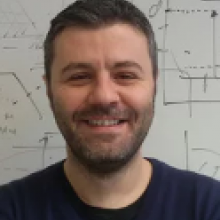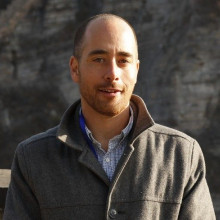


Austin Nevin is the Head of the Department of Conservation, at the Courtauld Institute of Art that unites Easel Painting and Wall Painting Conservation with transdisciplinary research on preventive conservation, technical art history, conservation science and conservation practice. His research focuses on the conservation and analysis of paintings, ancient and modern art on walls, easels and on paper and ranges from Chinese wall paintings to the analysis of Egyptian Polychromy and the analysis of red pigments from Leonardo´s The Last Supper. Trained as a conservator and conservation scientist he has worked as a Senior Lecturer at the University of Gothenburg and taught at the Accademia di Brera in Milan. Between 2011-2019 he was a Researcher at the Istituto di Fotonica e Nanotecnologie (IFN) in Milan, part of the Italian National Research Council. He completed post doctoral research at the Department of Physics at the Politecnico di Milano on applications of time resolved fluorescence spectroscopy to cultural heritage. Between 2004-2007 he was a Marie Curie Early Stage Research Fellow at the Foundation for Research and Technology (IESL-FORTH). Following a degree in Chemistry from the University of Oxford (2001), he obtained an MA in the Conservation of Wall Painting (2004) and a PhD at The Courtauld (2008). He is a Vice President and Fellow of the International Institute for the Conservation of Artistic and Historic and is an Editor of Studies in Conservation and of the Springer Series Cultural
Education
- 2004-10-01 to 2008-07-21 | PhD (Conservation ), Courtauld Institute of Art: London, London, GB
- 2001-10-01 to 2004-07-30 | MA in the Conservation of Paintings (Wall Paintings) (Conservation of Wall Paintings) Education, Courtauld Institute of Art: London, London, GB
- 1997-10-01 to 2001-10-21 | MChem (Lady Margaret Hall), University of Oxford: Oxford, Oxfordshire, GB
Career
- 2020-09-01 to present | Head of Department (Department of Conservation) Employment, Courtauld Institute of Art: London, GB
- 2019 to 2020-08-30 | Senior lecturer, University of Gothenburg: Gothenburg, SE
- 2011-12-01 to 2019-02-01 | Researcher, Istituto di Fotonica e Nanotecnologie Consiglio Nazionale delle Ricerche: Milano, Lombardia, IT

Costas P. Grigoropoulos received his Diploma Degrees in Naval Architecture and Marine Engineering (1978), and in Mechanical Engineering (1980) from the National Technical University of Athens, Greece. He holds a M.Sc. degree (1983), and a Ph.D. (1986), both in Mechanical Engineering from Columbia University. He joined the faculty of the Department of Mechanical Engineering at the University of California at Berkeley as an Assistant Professor in 1990, after serving as an Assistant Professor of Mechanical Engineering at the University of Washington from 1986-1990. He was promoted to Associate Professor in July 1993 and to Professor in Mechanical Engineering in July 1997. He has conducted research at the Xerox Mechanical Engineering Sciences Laboratory, the IBM Almaden Research Center and the Institute of Electronic Structure and Laser, FORTH, Greece. He is Faculty Staff Scientist with the Environmental Energy Technologies Division of the Lawrence Berkeley National Laboratory.

Interests:
Vasilis has research activities and interests in novel photonic systems and lasers in the visible and Terahertz spectrum. His interests are on THz spectroscopy, integrated microresonators and semiconductor quantum well lasers. His research has applications to diverse areas such as Quantum Science, materials science and medical applications.
Education
- BA in Physics from the National and Kapodistrian University of Athens
- MSc and Ph.D. in Laser science and technologies from University of Southampton.
Career
- Ecole Polytechnique Federale de Lausanne (2003 -2005)
- Marie Curie researcher in University of Cambridge
- University of Southampton - appointed lecturer (2007)
- University of Southampton - Associate Professor (2012)
- University of Montpelier - visiting research fellow (2016)
- University of Southampton - Professor (2022)
- University of Crete- Associate Professor (2023)


Liverios Lymperakis is an Associate Professor in the Dept. of Physics, University of Crete, and an Associated Researcher of IESL-FORTH. He studied Physics (Bachelor's degree) and Physics of Materials (Master's degree) at the Aristotle University of Thessaloniki. He contacted his doctoral work at the Fritz-Haber-Institute of the Max-Planck-Society in Berlin and received his Ph.D. from the University of Paderbon in 2005 with summa cum laude.
He worked as a group and project leader at the Max-Planck-Institut für Eisenforschung in Düsseldorf from 2005 to 2011 and from 2012-2021. His field of expertise is in Computational Materials with a strong focus on first-principles calculations and ab-initio-based multiscale calculations. His research addresses topics in the fields of science and technology of materials, such as properties and epitaxial growth of compound semiconductors, novel nano- and hetero-structures for optoelectronic and powerelectronic applications, and properties of bio-inspired and structural materials at the nanoscale.
Education
- 1997 First Degree in Physics, Aristotle University, Thessaloniki (Greece)
- 2000 MSc in Physics of Materials, Aristotle University, Thessaloniki (Greece)
- 2005 PhD in Physics, Universität Paderborn, Paderborn (Germany)
Career
- Since 2022, Associate Proffesor, Department of Physics, University of Crete
- 2012-2022, Head of the project group Growth Modelling, Computational Materials Design Department Max-Planck-Institut für Eisenforschung GmbH, Düsseldorf (Germany)
- 2012, Senior Researcher, Aristotle University, Thessaloniki (Greece)
- 2005-2011, Head of the Microstructure group, Computational Materials Design Department Max-Planck-Institut für Eisenforschung GmbH, Düsseldorf (Germany)
- 2000-2005,Research fellow Fritz-Haber-Institut der Max-Planck-Geselschaft, Berlin (Germany)



